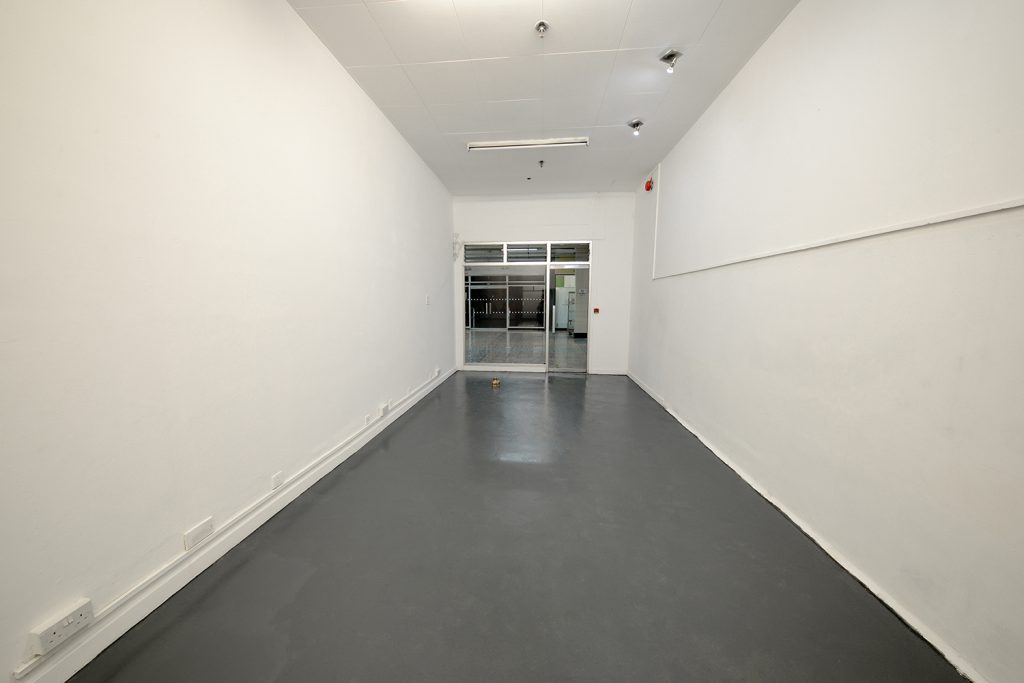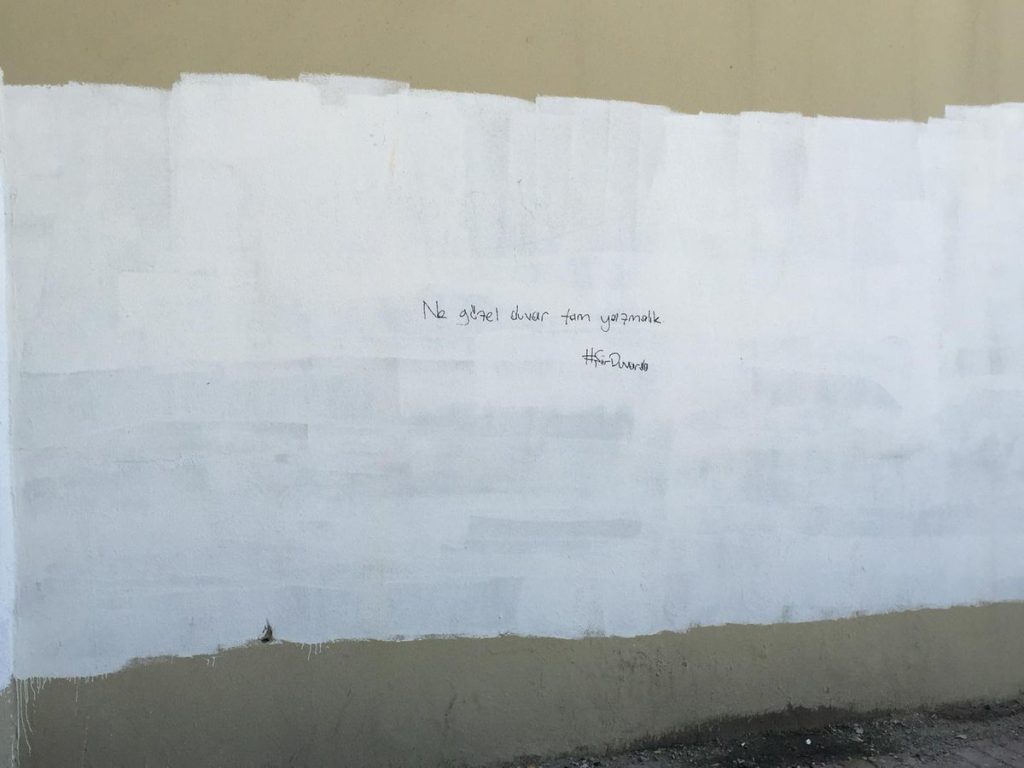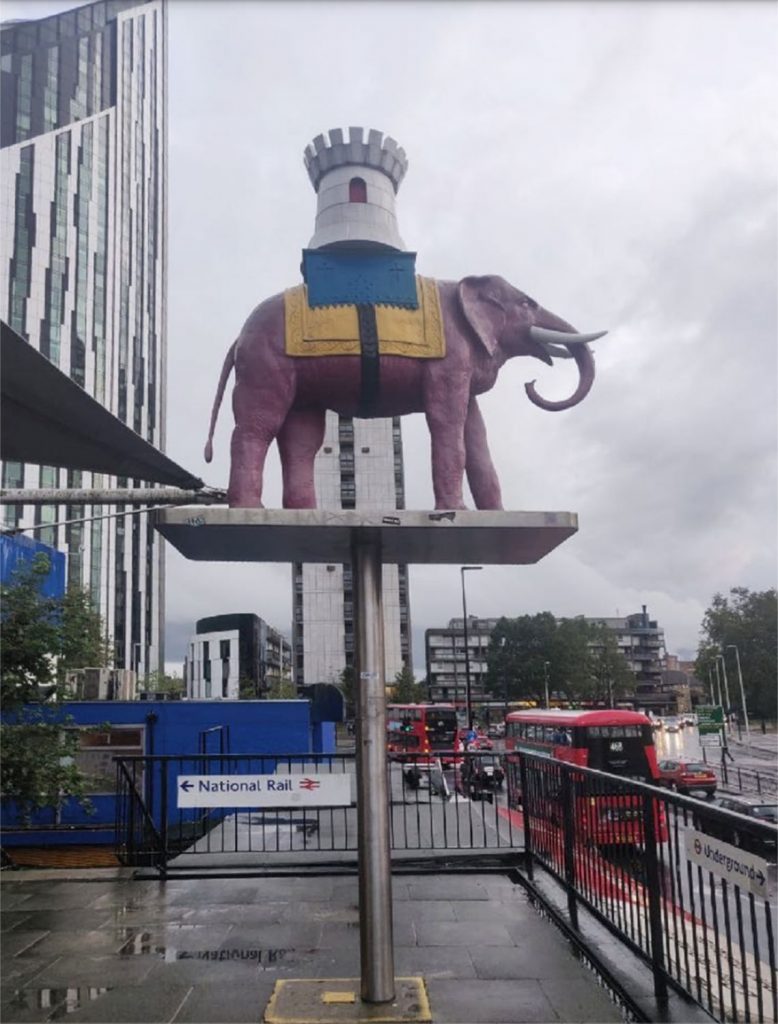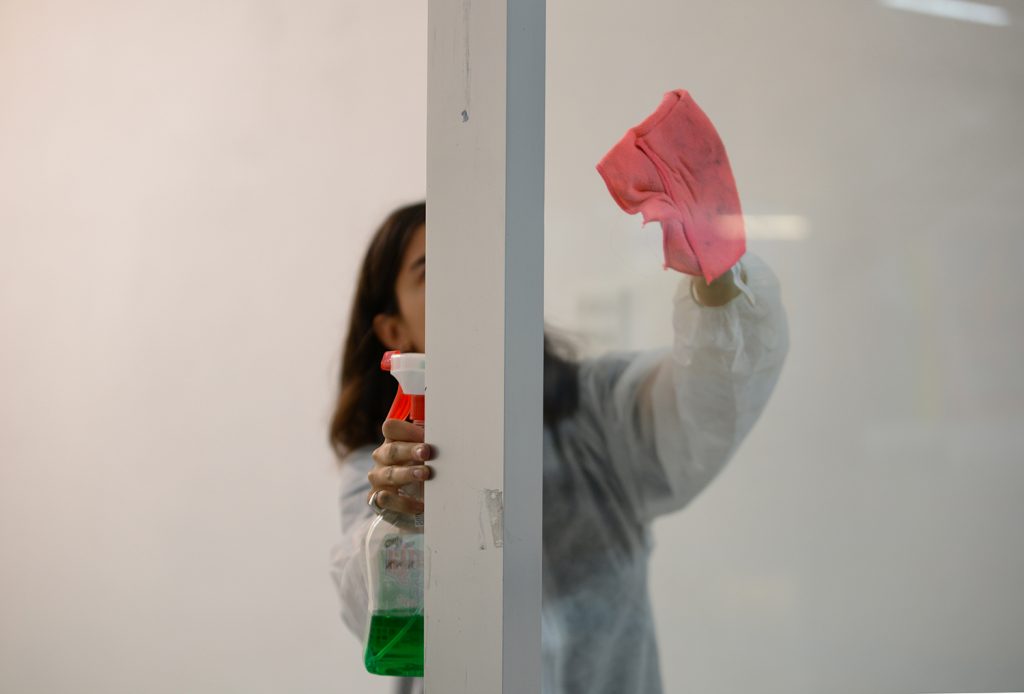Born and raised in Istanbul, Serra Tansel has a certain relationship to shopping malls. In the past years, public space has been increasingly disappearing and many green areas, especially in larger Turkish cities, have been replaced with luxury buildings and shopping centres. For maximum profit and encouraging consumption, the whole country has been turning into one huge commercial centre with Western names and aesthetics. Unlike the contemporary malls that tend to rise overnight in Turkey, London’s Elephant and Castle Shopping Centre was built in 1965, and has been home to Southwark’s Latinx community since the early 2000s. Tansel first visited the retail space in 2007 after relocating for her fine art degree, and found its surprisingly soft lightning and the soothing acoustics made it a place she has enjoyed spending time, reading a book, having coffee, meeting friends—until now.

“Being in the mall in its last week felt like being at a funeral,” say Tansel via Zoom from her London home, about the final days of Elephant and Castle Shopping Centre before it was closed for demolition on September 24, 2020, after 56 years. “People were coming by to pay tribute, to take photos and say their farewells to their favourite shops.” Set to be replaced with a new retail and residential building—as well as an University of the Arts London (UAL) campus extension—existing businesses were forced out by developers with the promise of being temporarily relocated with reduced rents during construction. They would then be returned to the new premises, but, of course, to a transformed neighbourhood serving a totally different clientele who can now afford to live there. The consumption needs and demands might not be met by the current stores, the fabric of the previous community having been wiped out for the slick aesthetics and higher rents of an increasingly gentrified South London area. The seemingly empty promises of protecting the interests of its current tenants neglects the social bonds and support networks built through the mall, as well as the emotional connection they have to the space. There are powerful invisible dynamics which will disappear, and they will either have to cater to the new demographics or go bankrupt.
Tansel has been addressing issues such as gentrification, the disappearance of public space and changing urban aesthetics in her work, using language as a tool to work through their complexities and absurdities. Her HIGHER solo exhibition, which ran at Istanbul’s Pilot Gallery last year, took its starting point from the names of the new property developments in the Turkish city. She made digital drawings of these half-Turkish, half-English names, such as Sunflower Altınorak (Turkish for ‘golden sickle’), or Balance Güneşli (‘sunny’), by taking them literally and trying to get a better understanding of a property developer’s vision.

Tansel’s “Passion can create drama out of inert stone”?! show—which ran at Peak Gallery in Elephant and Castle Shopping Centre on September 23 and 24—was a small gesture towards the changing aesthetics of the gentrifying neighbourhood and its histories. The name of the exhibition refers to a Le Corbusier quote from Towards a New Architecture in which he echoes the classist and condescending nature of his views on aesthetics. In reference to this, Tansel turned the small art space—once a hairdresser—into a perfect white cube to blend into the look the neighbourhood now demanded. Tansel’s performative intervention into the space and her take on the iconic Elephant and Castle statue not only points to the upsetting gentrification of the centre and the surrounding neighbourhood, but it’s also an invitation to think of many of the other sites and communities around the world, at risk of disappearing for financial profits for private developers, often backed by governments.
**I want to start by asking what your relationship to the Peak Gallery is and how the seeds of this project were planted?
Serra Tansel: Ayşe Köklü introduced me to Marilyn Thompson, founder of Peak Gallery. I didn’t have any ideas in mind at that point but was really attracted to the space and felt the urge to vocalize my frustration about the demolition of the mall. The rents for the new occupants were affordable because their contract was on a rolling basis as the date of eviction wasn’t definite. Yet, they weren’t allowed to criticise the regeneration of the area. Ayşe was referring to this clause in their tenancy contract as the elephant in the room and that’s where the idea of making this elephant visible came about.

When I went to visit the mall in July, I came across the posters prepared by the property developer, Delancey. They had photos of the traders who were being relocated. They were titled ‘The Herd’. This resonated badly with “herd immunity”, the members of the society who were pushed to take the risk of getting COVID-19 and produce the antibodies that could protect the rest. It was no surprise that the numbers of the COVID-19 deaths were much higher in Black, Asian and minority ethnic groups. The government was chanting ‘stay at home, save lives’ as it was pulling the ground from beneath its citizens’ feet, pushing them onto the streets.
**What will happen to the site now that the mall is demolished?
ST: The mall will be replaced with some super-slick buildings but our opposition is not only towards the new aesthetics. Delancey’s residences are not being built in line with the Elephant’s current affordable housing policy, and the promise of giving all the traders discounted retail units will not be fulfilled. Although Delancey does not pay any corporation tax in the UK, it generously donated £100,000 to the Conservative Party in January 2020. UAL—so engaged and so proud of its role in London’s development— has apparently banned the LCC [UAL’s London College of Communication] tutors from criticising Elephant and Castle regeneration.
**The name of the exhibition refers to a certain aesthetics that is catered towards social cleansing and whitewashing. Can you say a little bit more about that?

ST: “Passion can create drama out of inert stone” is a quote from Le Corbusier’s manifesto book Towards a New Architecture. This was a reference to modernism’s whitewashing; its aesthetics, how it affects the psyche and its social implications. It was also creating a link between the white cube gallery and the new spaces that were due to replace the shopping centre. The stripped-down aesthetics that don’t allow the personal expression is very disorienting. Le Corbusier perceived the house as a machine and was very motivated by efficiency. This resonates with London’s new property developments. Le Corbusier speaks about painting everything white as a form of spiritual cleansing. His comments on taste and class reveals that he’s not only speaking about the colours of the walls. This seems relevant to why the Elephant and Castle mall wasn’t ‘tolerated’ in the heart of London.
**But this whiteness creates a hole where what you’ve tried to erase or eliminate is ever present. I’m thinking of Turkey’s 2013 Gezi protests, and how afterwards we started seein g this grey paint covering the writings and graffiti all around. When you’re trying to get rid of something so hard, what you replace it with becomes just another placeholder for what’s been erased. It is even more visible.
ST: Someone or something’s absence can be much more dominating than their presence.
**You turned the space into a white cube, and exhibited a tea mug inside.

ST: I found a vintage souvenir teacup on eBay in the shape of the Elephant and Castle statue that was sitting in front of the mall. There are various stories about the origins of the name Elephant and Castle and this symbol. Royal African Company, an English company set up in 1660, the biggest company in the Atlantic slave trade, had an elephant carrying a castle on its back in its logo. The same elephant and castle crest also honoured the Worshipful Company of Cutlers, a company founded to produce fighting weapons using ivory, which then shifted its focus to cutleries. Although a very colonial icon, it was the mascot of the mall and people generally found it cute.
I painted this tea cup in gold as a reference to Ian Fleming’s Goldfinger book, made into a James Bond movie. The story had its inspiration from Ernő Goldfinger, a modernist architect who designed Alexander Fleming House—a heritage-listed group of residential buildings at the Elephant and Castle junction. The fictional Goldfinger is a gold thief, and James Bond—whilst on a mission to catch Goldfinger—goes to bed with his lover Jill. Getting caught in their love bed, Jill is murdered by Goldfinger’s bodyguard, aka Odd Job, who paints her top-to-toe in gold. At the time, it was believed painting the whole body in gold was lethal as the paint would block one’s pores and raise the body temperature. I found the metaphor of suffocating in gold to be very powerful and it was a good representation of London’s gentrification. Grenfell Tower didn’t have its fire safety measurements in place, as the council preferred to spend the money on its flammable cladding which made it look prettier.
I brewed tea and left it inside the cup as another reference to detective movies. The temperature of the tea could be a way to measure our distance from this place. Also, as people were preparing to move out and the mall was turning into a construction site, there were teacups everywhere. My full cup sat there to show something was left unfinished.

**This also made me think of the story of King Midas, whose touch turns everything into gold and who nearly dies of starvation because of this.
ST: Yes, indeed.
**I’m curious to hear a bit about how the audience and the shop owners responded to all this.
ST: They were surprised to see me painting the walls, fitting new light bulbs, and kept warning me that the mall was due to be demolished. Turning the space into a white cube was a performance and it was very enriching to have small interactions with passersby. The security guards took the rules and regulations very seriously until the last minute. They reminded me of the musicians playing their violins as the Titanic was sinking.
We didn’t have an opening because of the pandemic but my friends who live locally, or have an emotional attachment to the mall stopped by. We had a small gathering to experience the mall together for the last time.
**The timing is also quite interesting. Public space has almost completely vanished lately. Such gathering spaces are the backbone of marginalized communities, and are crucial for creating conditions of care and conviviality. With the pandemic, digital spaces are somehow becoming gathering spaces. We should use it as a tool to start conversations about the disappearance of public space, gentrification, privatization. I believe they are also spaces of protest and resistance.
ST: Yes, I agree. Even some streets are getting privatized now, and have their own rules and regulations. The boundaries can be quite invisible unless you challenge them. I was walking around the city the other night and the streets are very quiet because of the pandemic, so I could hear the high-pitched beeping noise emitted from a supermarket, in order to repel homeless people sleeping in front of the shop. Even though the street is not the supermarket’s property, there’s the entitlement of taking over the street.

**Same with benches with armrests, or spiked window sills. They are delineating the borders between public and private through hostile architecture.
ST: Yes, and one might not recognise these structures until they need to use that space to sit or lay down… A space can have its doors wide open to everyone but can still make itself very inaccessible and uncomfortable. There is a whole science behind using harsh lighting, playing certain types of music to encourage people to consume quickly or feel unwelcome. A space might be accessible but unbearable. I think Elephant and Castle Shopping Centre was a very comfortable space in that sense.
**It’s such a shame to see it becoming merely a space for consumption, rather than a social space; the same with the developers pretending to give the shop owners a spot in the new mall. They’re not explicitly kicking them out but they’re doing it in a more subtle way. They’re putting them in a condition where they will be forced to leave. The system creates the illusion that you have a choice and that you make a decision but in fact it’s already designed in a way you’ll respond the way you do.
ST: Yes, very much so. I think it is very important to share our experiences with the invisible borders and obstacles. “Passion can create drama out of inert stone”?! was my way of picturing all these links between different forms of dispossession .
**You use language in a very particular way. There are layers to how a word starts meaning something else. You use language to shake these, and meddle with them strategically. Intervening in the dominating language is important.
ST: Language can be very playful and manipulative. Quoting something in a new context can change its meaning completely. I sometimes use language as a found object. I also like visualising language like how I visualised the phrase ‘the elephant in the room’.

**You are someone who migrated to the UK many years ago but regardless of your passport or whether you have a permanent accommodation somewhere, we experience statelessness or uprootedness in various ways in our current world.
ST: We’re constantly losing orientation. Even if we root ourselves somewhere, our surroundings are changing very quickly, and we find ourselves out of context again.
**All these forms of disorientation are entangled and this entanglement is manifesting itself in different ways depending on the specificities of your conditions.
ST: Yes. My friend Murat Abi was a shoe maker and had a small shop in Taksim, Istanbul. He inherited the craft and the shop from his father. In 2016, he was evicted by the police from his shop that he grew up in. Murat had a heart attack and passed away a year later at the age of 55. “Passion can create drama out of inert stone”?! was in Murat Abi’s loving memory, as well as showing gratitude to all the shop keepers of the Elephant and Castle shopping mall and standing in solidarity with the Save Latin Village activists of Seven Sisters.
We’re ruled by one global financial system, and the lifestyle marketed in all parts of the world is pretty similar. People are encouraged to draw very thick borders around their homes, missing that the whole planet could be their home if they perceived it to be.
**When you address one manifestation of these issues at play, you are actually working towards the bigger issue.**













